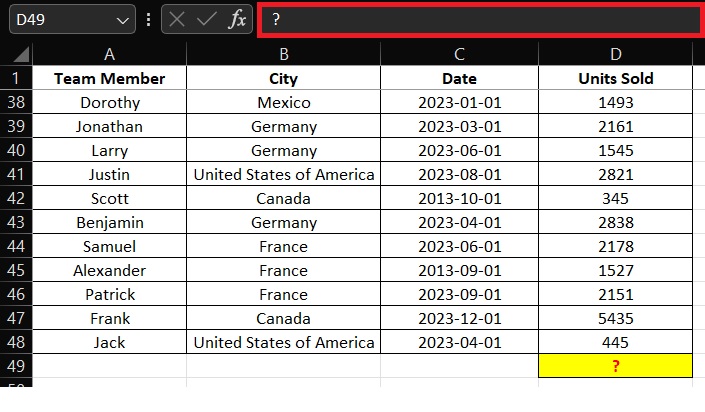Have you ever found yourself buried in an Excel spreadsheet, scratching your head over a single cell’s value? Well, if that cell happens to be D49, and you’ve wondered, “What Value Would be Returned in Excel D49?” – you’re in the right spot. In this blog post, we’re going to dig into Excel’s bag of tricks to uncover the mystery behind D49’s value.

Getting to Know D49
Excel, with its endless functions and formulas, can sometimes feel like a maze. D49 may seem like a simple cell reference, but underneath, it could be hiding a complex calculation that holds the key to its value. To unlock this puzzle, let’s take a few steps:
Step 1: The Formula Check
Start by clicking on D49 and peeking at the formula bar. Is there a formula there, or is it just a plain old number? If there’s a formula, it’s time to roll up your sleeves and break it down.

Step 2: The Formula Breakdown
For cells with formulas, Excel has this cool feature called “Evaluate Formula.” Click on the cell, head to “Formulas,” and hit “Evaluate Formula.” This nifty tool walks you through each step of the calculation, helping you decode how Excel cooks up that final value.

Step 3: Hunt for Dependencies
Sometimes, D49’s value relies on other cells or outside data sources. Keep an eye out for links, references, or connections to external data that might be pulling the strings behind D49. These dependencies can be key players in the D49 value game.
Step 4: It’s All About Presentation
Formatting can play tricks on your eyes. Check if there are custom number formats, conditional formatting, or data validation rules applied to D49. While they might not alter the core value, they can certainly change how it looks.

Step 5: When in Doubt, Ask Around
If D49’s value still has you stumped, don’t hesitate to call in reinforcements. Your colleagues, online Excel communities, or the local Excel guru can be invaluable resources. Sometimes, a fresh pair of eyes spots what you missed, and experts bring insights you might not have considered.
Going the Extra Mile: Advanced Tricks
For those who want to level up their Excel game, consider these advanced moves:
1. The Art of Array Formulas
D49’s value might be tied to an array formula – a potent, albeit perplexing, Excel feature. Dive into the world of array formulas to grasp their power and their potential impact on D49.

2. Taming Dynamic Data
D49 could be dancing to the rhythm of dynamic data sources, like external databases or web queries. Explore how Excel connects to external data and how it can sway D49’s value.
3. Navigating Excel’s Error Maze
Excel isn’t shy about throwing error messages your way. Learn about common errors like #DIV/0! or #N/A and how they can influence D49’s value. Implement error-handling techniques to keep your spreadsheet in line.

Wrapping It Up
In Excel’s realm, D49’s value can be as dynamic as the formula behind it, the data it references, or the formatting it wears. Armed with the steps we’ve laid out and the advanced techniques we’ve uncovered, you’ll be better equipped to unveil the enigma of D49’s value and master Excel’s intricate world.
So, the next time you cross paths with Excel D49, you won’t have to wonder, “What’s the deal with Excel D49?” – because you’ll have the tools and know-how to uncover the answer yourself. Happy Excel-ing, and may your spreadsheets always reveal their secrets with ease!
What Value Would be Returned in Excel D49
You Could be interested to read “How to Swap Rows in Excel?“
1 thought on “What Value Would be Returned in Excel D49?”